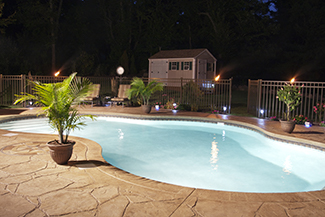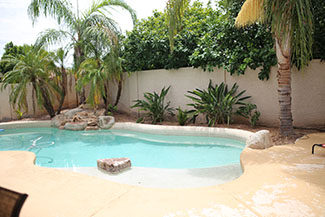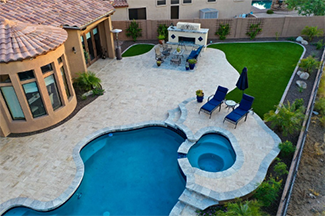What Are The Pros and Cons of Kool Deck vs. Acrylic Pool Deck vs. Pavers?
Kool Deck VS Acrylic Pool Deck
It used to be that every backyard swimming pool looked just about the same. Everybody relied on the same product to keep the deck around the pool comfortable under bare feet: Keystone Kool Deck.
Today we have many material and design options to choose from. Before selecting a pool deck product take these things into consideration:
- First and foremost, is it safe and slip-resistant when wet?
- Is the material coarse, bumpy, or uneven?
- Is it heat-reflective? Will it remain cool on hot days?
- Will it blend well with other paved or hardscaped areas in your yard?
- Is it resistant to algae, chemicals, acid, mold and mildew, and frost?
- Is it compatible with chlorine and/or saltwater systems?
Let's break them down.
Kool Deck

Kool Deck is a premium, trademarked product, not to be confused with cool deck which is a common term that is used to refer to textured or stamped overlays for pool decks. Keystone Kool Deck was invented in 1962 by Mortex in Tucson as a surface coating over concrete swimming pool decks, walkways, and patios. Applied to freshly poured concrete, Kool Deck creates a colored, textured concrete surface that the manufacturer says is as strong as the base concrete.
If your pool deck was built before the mid-1990s, it’s probably covered with that familiar mottled-beige concrete.
“We are not seeing as much Kool Deck nowadays,” says Manny Sanchez, past president of the Pool & Hot Tub Alliance, Southern Arizona Chapter. “We are seeing more and more customers selecting acrylic overlays because it offers multiple types of applications from spray texture to stamp patterns such as flagstone, tile, or slate.”
Kool Deck Pros:
- Lowers the surface temperature of concrete by around 20 degrees-- more than any other deck material.
- Withstands thermal expansion and contraction better than concrete.
- Is fairly easy to clean.
Kool Deck Cons:
- Because it's more complicated to install than acrylic, it takes someone trained specifically in the use of that deck topper. If you go with Kool Deck, make sure your installer is trained and experienced in applying this specific material.
- It fades under the Arizona sun, and its color is hard to match if you have to patch it during a repair.
- Must be applied to freshly poured concrete before the concrete cures to bond properly.
Acrylic Pool Deck

An alternative to Kool Deck is a thin coat of acrylic or polymer concrete, usually, a mixture of modified acrylic resin, Portland cement, and sand, applied over plain concrete to give it a texture.
Acrylic Pros:
- Can be fashioned to look like flagstone, Saltillo tile, brick, and even Kool Deck.
- Can be acid-stained or custom-textured for a unique look around the pool.
- May be applied to new or old concrete.
- Is usually finished with a solvent-based sealant that makes it stain-resistant and easy to clean.
Acrylic Cons:
- When textured, it's cooler than plain concrete but not as cool as Kool Deck.
- Can cost up to twice as much as Kool Deck.
Pavers
Pavers have gained popularity for pool decking and according to Sanchez are the most popular choice. Stone, brick, and concrete are the three main materials used to make pool pavers.

"Travertine and artistic pavers are now the kings," said Sanchez. "It takes more time to install but offers a much more customized finish without the cracking or delamination like the 'old' stuff."
For a look that's a bit different, consider Belgard's Oceanside pavers. They combine coquina and oyster shells for additional durability and natural beauty.
Paver Pros
- A good alternative to plain concrete because they can be designed to resemble cobblestones, granite, tile, or traditional bricks.
- Can be arranged to complement many types of design schemes because of the large variety of shapes, colors, and sizes.
- Can be custom-made.
- Easy to find and easy to replace if a paver gets damaged.
- If installed correctly, many manufacturers claim that interlocking pavers are frost proof.
- Endure a high resistance to wear and tear and a durable non-slip surface.
Paver Cons
- When installing, it requires a permanent border or frame to prevent shifting.
- Can appear industrial or commercial.
- If made of concrete, it is important to seal them properly to prevent fading from excessive water damage and sun exposure.
- They can get VERY hot!
Whatever system you choose, if you are remodeling your deck and time is not an issue, do it in the cooler months to prevent cracking.
To maintain the deck, keep it free of dirt, debris, and leaves, which can end up in the pool. Brush them away from the pool. Be careful about power-washing. The pavers can move or the coating damaged. Usually, a simple wash with from the garden hose and a few swipes of a gentle scrub brush is all you need to keep your deck looking pristine while maintaining its safety features.
Home maintenance To-Do | #PoolDeckOptions
###
Podcast
Upcoming event to protect your catalytic converter. Homeowner questions include an air conditioner that seems to be running when its completely turned off, 2 questions concerning a different home soft water system issue and a wet closet next to a shower after use.
Photo Credit
- Shutterstock
Related Content
- Blog: 6 Ways To Pour Life Into Your Aging Pool
- DIY FAQ: Overlay Your Pool Deck With Pavers
- DIY FAQ: How can I keep my pool deck looking nice?
- DIY FAQ: Refreshing Your Pool For A Refreshing Dip In The Summer
- DIY FAQ: What are Rosie’s General Guidelines For Choosing A Pool Deck Surface?
